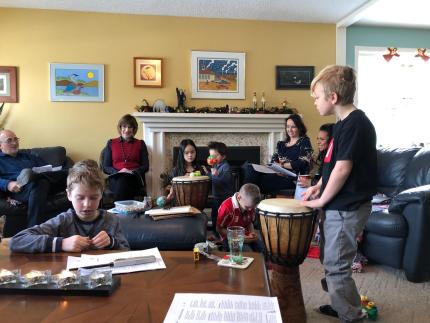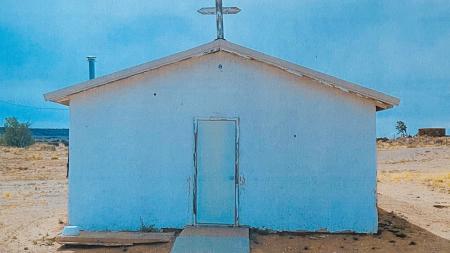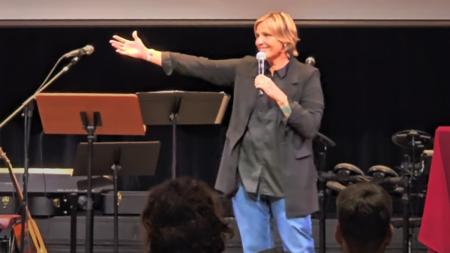Getting to Know Your Neighbors

As on many Sundays, the gathering for worship began with a potluck brunch in the home of Dr. Karen Wilk, a former youth minister and church-plant pastor who now leads a ministry called Neighbourhood Life in Edmonton, Alta.
After choosing from a number of tasty dishes, people took their plates and sat around a large dining table in a room off the kitchen. As they ate, everyone caught up on events and activities in their lives and in their neighborhood of Laurier Heights, a mostly middle-class area in west Edmonton overlooking the North Saskatchewan River.
I had a chance to attend this worship gathering along with Moses Chung, innovation leader for Resonate Global Mission for a project I am working on about innovative ministries in the Christian Reformed Church. Sitting next to me at the table was Donna McLeod, who worked as an assistant school principal in Calgary before moving to Edmonton four years ago so that her husband can attend graduate school.
“When we came here, I had a chance to recreate my life,” she said as her young son twisted and played in her lap.
While McLeod had grown up attending Baptist churches, attending a traditional church in Edmonton was not part of what she had planned as she rearranged her life. Becoming more involved in her neighborhood, however, was something that attracted her.
She met Karen, who got her involved, and now McLeod serves as a “block connector” — someone who gets to know and helps their neighbors.
Over time, McLeod has built relationships with the neighbors in her area, even those who initially weren’t particularly receptive. She has come to know who is sick, who has lost a job, who is getting divorced, and who is celebrating the birth of a child. In various ways, she helps these neighbors, and they help her family -- perhaps with a meal, a card, or especially the chance to pray and talk together. Connecting with her neighbors is a role she considers a ministry.
“You can’t know when being a good neighbor is going to be critical to your life or their life. I see that loving your neighbors and learning who they are is what God wants us to do,” she said.
When we finished eating, we went into a large room that had windows at one end, showing the backyard and a park beyond. Decorations for Christmas were scattered around — angels; a manger scene with Jesus, Mary, and Joseph; lights; and an evergreen branch draping the mantel above the fireplace.
The worship service began as everyone took seats and most of the children sat on the carpet. The younger ones were a little noisy, but that was fine. Later they would go downstairs to play. Most of those who were there that morning were from Laurier Heights, but some had driven in from other areas.
“We’ve been talking about Christmas symbols,” Wilk said near the start, aiming to weave common items of life into a discussion about something sacred.
“The candy cane is a symbol of a shepherd’s staff, and Jesus is the shepherd. The red symbolizes the blood of Christ, and the green symbolizes new life. As the stripes wind around, they symbolize the love of God that never ends.”
Besides serving her immediate neighborhood, Wilk coordinates similar efforts in other neighborhoods in Edmonton. She is the author of books such as Don't Invite Them to Church: Moving from a Come and See to a Go and Be Church, and she serves as a member of the regional mission team for western Canada with Resonate Global Mission.
Bringing the gospel to the very places in which people live is now her focus, but she started out as a youth minister at West End CRC and then became part of a church plant in Edmonton. She loved the work, she said. But then a few years ago she went to a conference where she learned about the missional church conversation, about God as the sent and sending One and therefore how the church does not have a mission but the mission of God has a church. This new understanding was the beginning of a big change for her in terms of understanding what it means to be the church and to discover and join the Spirit on God’s mission. Alan Hirsch, founding director of the Forge Mission Training Network, was one of the speakers who had a profound impact on her.
Wilk also read his book The Forgotten Ways: Reactivating the Missional Church, in which Hirsch discusses hands-on, community-focused missional practices used in the 20th century in many places around the world, and he makes the case that these practices should be employed in North America today.
Using as a model the early Christian church before it was institutionalized in 310 A.D. by the Roman emperor Constantine, Hirsch calls for a return to a faith that is shared and grows in a community. It is a grassroots approach that responds to the daily and practical needs of people with whom you live.
Hirsch writes about a new missional church “that is a community of God’s people that defines itself, and organizes its life around, its real purpose of being an agent of God’s mission to the world. . . . The mission of God flows directly through every believer and every community of faith that adheres to Jesus.”
Wilk responded to this message. It shook her up, forcing her to begin to pay more attention to her neighbors and what God was calling her to do. Additional reading, attending conferences, and talking to others convinced her that the Christian church needed to change its emphasis on Sunday worship and place it on neighborhoods. About five years ago, after moving in this direction under the umbrella of the church plant, she and others felt God’s leading to begin Neighbourhood Life.
“As I paid attention to the neighborhood, I saw that God was doing a brand-new thing,” she said. “I saw God working in the lives of people who were disconnected from church but were clearly engaged in kingdom practices.”
Making this change in approach to ministry has repeatedly proven to have been a good idea, she said; she sees confirmation in many ways and has learned important lessons as Neighbourhood Life has moved forward. The Spirit continues to show Neighbourhood Life where the Spirit is at work and how they can join in what God is already doing in their neighborhoods and communities, she said.
“Over and over again, God has been ahead of us,” she said. “God has opened doors and inspired us. We have many stories of how the Spirit has healed brokenness, nurtured caring community and human flourishing . . . [for] the peace and well-being of the city [Jer. 29:7].”
Rich Braaksma, a pastor at a church in Calgary and Resonate’s regional leader in western Canada, said large churches such as The River, where Karen served, are thriving and will probably continue to do so.
“They have resources and programs that attract people. But smaller churches, neighborhood churches like Karen is promoting, are growing in importance because, I think, people are looking for that kind of intimacy.”
Sitting in the room at Karen’s house that morning, along with others involved in Neighbourhood Life, were people from a range of religious backgrounds. Some had grown up in the CRC and still considered themselves members of the church; some had been active in commuter congregations as worship leaders and council members; some had drifted away from God for periods of time; some had been hurt by the church; and some had found big churches too impersonal and their programs theatrical.
But a common thread tying all of these worshipers together is a hunger for a more personal experience of church — connecting with God and their neighbors. As Wilk put it, they want the place where they live to be their community, where they do life — including worship and spiritual formation — together as neighbors. A longing for a more local, personal, and connected way of being is what grounds them — and they no longer have to commute anywhere.
“Even though I’m struggling with a serious illness, God comforts me,” said Julie Rohr before the service. She sat at one end of the room with her husband, David. “I once saw God as vengeful and angry. Now I see God as a loving creator.”
Julie struggled with her feelings about God after she went through a divorce. But meeting David, starting back at a small church, and then being introduced to Karen, who got her involved in her neighborhood, has brought her faith back in a new and startling way, she said. Learning about the lives of her neighbors and having them over for meals or simply to talk has added an abiding sense of abundance to her life. “The presence of God is so real to me now,” she said. “I’m having a beautiful walk with God that I never thought I’d experience.”
Not present that morning were Carla and Mike Stolte. They are connected with Neighbourhood Life and have started a neighborhood church in their community of Westmount. Mike has strong roots in the CRC and was reluctant to get involved in neighborhood ministry when Carla, who also grew up in the CRC, felt a call to do so. She was inspired after volunteering time and participating in Edmonton’s Abundant Community initiative, helping her neighborhood become a healthier and more connected place.
“I felt increasing discontent with the organized church community and was more and more intrigued by the house church,” she said.
A turning point happened three years ago. After meeting with like-minded Christians in the neighborhood, the group hosted a gathering in Westmount, inviting neighbors to one of their homes for an Advent gathering, which included reflections, Scripture, and carol singing on a Sunday evening. When over 70 people showed up, “it felt like a Holy Spirit moment,” she said. She was convinced a neighborhood church was possible — and soon Mike agreed.
“When we left our old church [a CRC congregation], we left well,” said Mike, a psychologist. “The church saw that we were called to this ministry.”
Edmonton, a city of nearly a million people, has more than 150 designated neighborhoods and has launched the Abundant Community initiative to connect and offer resources to every person on every block of the city. As a city, Edmonton does this as a way to support and encourage good neighborly relationships, not as a kind of ministry.
Yet, serving as coordinator of the effort is Howard Lawrence, former pastor of a large Baptist church in Edmonton and a strong backer of the work Karen Wilk is doing.
He still views things through the lens of his faith, though he doesn’t emphasize that when working for the city, he explained. “The Bible doesn’t focus on the family; it focuses on neighbors,” said Lawrence. “This is about God seeking shalom in the places you live. ‘Love your neighbor’ is the best commandment. There is less child abuse and less violence, and people who are sick are more likely to receive help when you know your neighbor.”
During the service at Wilk’s home, one of the children lit the Advent candle for that week and recited a prayer. The group sang some familiar Christmas songs, and then Karen led a time of teaching from Luke 2:1-7, in which Joseph and Mary travel to Bethlehem at the time of a census. While there, Mary gives birth to Jesus and wraps him in cloths and places him in a manger because “there was no guest room available for them.”
Karen asked those in attendance why people in Bethlehem made it so that Jesus had to be put in a feed trough for animals. Was that a sign, on a larger scale, of the world rejecting Jesus and forcing him to be born among animals?
People speculated on that, saying perhaps it was a sign of people seeking to shun Jesus.
But Wilk offered a different take on it. “Think of it this way: Joseph is of royal blood, the house of David. People there knew him. This was his hometown, his neighborhood. And in that culture and time, hospitality was an essential practice. No community would allow for a woman giving birth to be left alone and uncared for! As Kenneth Bailey in his book, Jesus Through Middle Eastern Eyes, explains, the typical peasant’s home at that time would have had animals in a room attached to their living quarters — the animals would provide warmth for the occupants at night, and the manger would have been between the two rooms.”
“Perhaps the town was packed with people who were there for the census. Perhaps the people of Bethlehem gave Joseph and Mary the best accommodations possible, under the circumstances. Perhaps the story is all about making room for and loving your neighbor.”
Most importantly, she said, “Perhaps this is about the flesh and blood of God being born in the neighborhood.”


